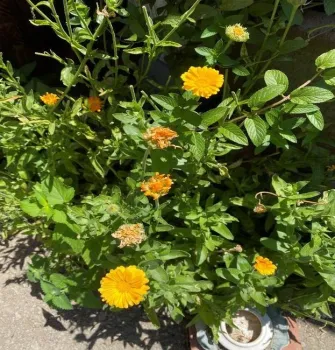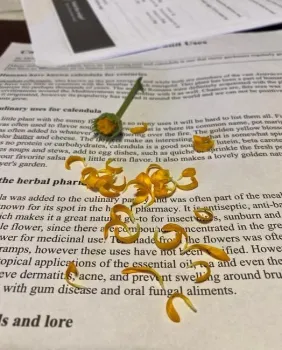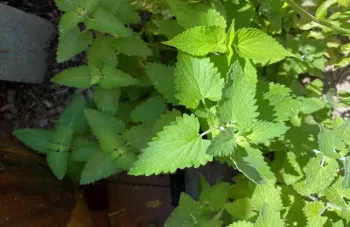Summer Herb Study 2022

The brightly colored petals have been used to add color to butter and cheese, as well as margarine in modern times (pale, almost white butter substitutes were found to need a little more color to be more marketable). Teas made from the petals are somewhat spicy and bitter, but pack a significant amount of lutein, beta carotene, and antioxidants. The petals may also be added to egg dishes – scrambled, omelet, or quiche do well with the bright color and texture.
A side note: Calendula was supposedly the flower that begot the iconic “he loves me – he loves me not.” Petal-pulling activity as it seldomly ended up the same answer from one flower to the next (unlike a daisy wherein I believe the activity always ends with the same result [not] due to them having an even number of petals). The pulling petals off a Calendula is challenging as it is more difficult to grasp the petals individually; so, the number of times a response is made will vary with the voracity of the pulling activity, making it easier to come up with the desired answer – HE LOVES ME!

Historically, the flower was named by the ancient Romans, noting that the plant always had blooms on the “kalends” (first day) of each month. It was a symbol of joy to them and cultivated it in their gardens to spread happiness.
Today, the plant is cultivated for its seed and incorporated into chicken feed to enhance the color of the yolk of the chicken eggs and the color of the chicken's skin. Marketing plays a part in so many things!
Catmint
If someone had told me 40 years ago that “Catmint” was a real thing I would have just dismissed them as an uninformed or confused herbal advocate and attempted to correct them saying “you mean catnip”. Both are species of Nepeti; however, Catnip (Nepeti cataria) supplies little value to gardeners other than attracting unwelcome rogue feline interaction. Catmint (Nepeti mussinii) is less attractive to feline visitors and much more appreciated for its dried leaves, stems, and flowers which may be used to flavor soups and sauces. It is also a favorite herb for teas aimed at calming nerves, relieving congestion, and suppressing coughs. Thankfully, I have a much more open mind now as well as the data to support and understand the differences and uses of catmint. This plant is in our garden.
An aromatic herb, Catmint produces flowers of a lavender-blue hue atop gray-green foliage. It makes for a nice “edge” to separate the various areas of a multiuse garden.
After a tremendous infestation of black aphids in our side garden late last year, we now incorporate its use as a companion plant with onion, garlic, and chive beds. It adds a soft image to the sometimes stark-looking scallions or the even more stark mature onion which drops its leaves as it bolts a seed-head (cluster of tiny white flowers). It can also help to keep away other pests such as Japanese beetles. (We are closely watching to see if it also deters Hoplia.)

Catmint blooms throughout the summer and fall. If you prefer a bushier plant, just pinch the tops off and it will gain added width. While deadheading promotes more flowering, it prevents re-seeding. There is a cross which is sterile and doesn't require deadheading (Nepeta x faassenii).
